005PermittoWorkManagement工作许可证管理14页
EHS-18 工作许可证制度 O

Permit to work management procedure
工作许可证制度
1. 目的
2. 应用范围
3. 术语、定义和缩写说明
4. 责任和说明
5. 流程
6. 附件
7. 更改历史
1. 目的
加强安全作业工作监督管理,严格规范高风险作业安全作业工作条件,杜绝违章操作,防止和减少高风险作业安全事故,保障员工人身和公司财产安全。
2. 应用范围
公司内所有部门及个人,在其进行高风险作业时,均实行本工作许可证制度。
生产部门或个人未在作业前取得工作许可证的,不得从事高风险作业活动。
3. 术语、定义和缩写说明
高风险作业:存在危险因素较多、风险较大,非日常性、非常规操作的作业项目或经风险识别存在高风险的作业项目。
主要包括:电力作业,登高作业,受限空间作业,挖方作业,动火作业,承包商作业,起重作业,车辆作业等。
工作许可证:进行高风险作业的作业凭证。
4. 责任和说明
5.
流程
6. 附件
PTW for working at height.docx PTW for LOTO.docx PTW for lifting.docx PTW for hot work .docx PTW for contractor.docx PTW for confined
space.docx
7.
更改历史
Change History。
work permit residence permit -回复
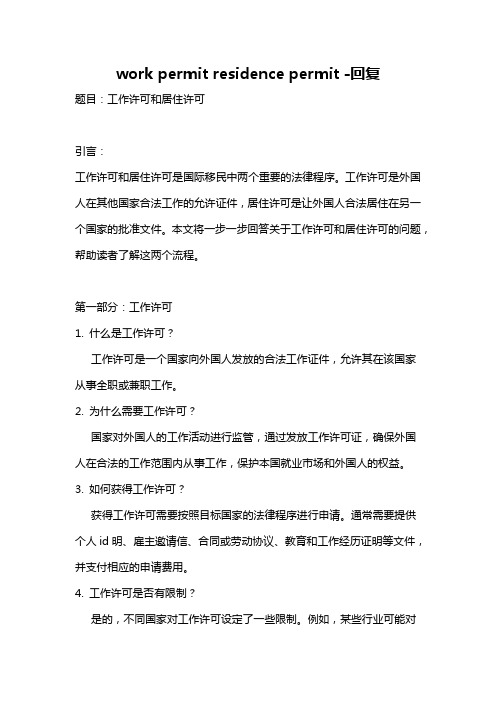
work permit residence permit -回复题目:工作许可和居住许可引言:工作许可和居住许可是国际移民中两个重要的法律程序。
工作许可是外国人在其他国家合法工作的允许证件,居住许可是让外国人合法居住在另一个国家的批准文件。
本文将一步一步回答关于工作许可和居住许可的问题,帮助读者了解这两个流程。
第一部分:工作许可1. 什么是工作许可?工作许可是一个国家向外国人发放的合法工作证件,允许其在该国家从事全职或兼职工作。
2. 为什么需要工作许可?国家对外国人的工作活动进行监管,通过发放工作许可证,确保外国人在合法的工作范围内从事工作,保护本国就业市场和外国人的权益。
3. 如何获得工作许可?获得工作许可需要按照目标国家的法律程序进行申请。
通常需要提供个人id明、雇主邀请信、合同或劳动协议、教育和工作经历证明等文件,并支付相应的申请费用。
4. 工作许可是否有限制?是的,不同国家对工作许可设定了一些限制。
例如,某些行业可能对外国人设有配额限制,而其他行业则可能对高技能外国人有更宽松的政策。
第二部分:居住许可1. 什么是居住许可?居住许可是指一个国家允许外国人在其境内合法居住的批准文件。
2. 为什么需要居住许可?外国人需要居住许可来合法地居住在目标国家,享受当地的社会福利和公共服务。
居住许可也有助于目标国家管理外国人群体。
3. 如何获得居住许可?获得居住许可通常需要向目标国家的移民局提交申请,并按照其规定提供个人id明、住房证明、健康证明和金融担保等文件。
4. 居住许可是否有限制?是的,不同国家对居住许可也有一定的限制。
这些限制可能包括财务要求、语言能力要求、担保人要求等。
结论:工作许可和居住许可是国际移民领域中两个重要的法律程序。
工作许可允许外国人在其他国家合法工作,居住许可则允许外国人合法居住在目标国家。
要获得这两种许可,个人需要按照目标国家的法律程序进行申请,提供相关文件和证明,并支付申请费用。
外国人来华工作许可制度

审批对象
适用范围
用人单位
Employing Entities
外国人
Foreigners
基本条件
Requirements for Approval
明确来华工作外国人条件,分类管理
申请人
Requirements for Applicants
外国专家 来华工作许可
foreign experts work permit
外国人就业证
Alien employment certificate
外国专家证
Foreign experts certificate
外国人 来华工作许可通知
Notification Letter of Foreigner’s Work Permit
Notification Letter of Foreigner’s Work Permit E-version
直接在线打印 无需寄送至境外 相关信息数据 交换外交部门
工作签证 (Z签)
Invitation letter
(canceled)
持外国人工作许可通知 和签证邀请函(取消)
iii personnel
外国专业人才 (B类)
Foreign Professional Talents
(Category B)
其他外国人员 (C类)
Other Foreigners (Category ห้องสมุดไป่ตู้)
遵循原则
大力引进外国高端人才,突破年 龄、学历、工作经历等限制,精 简材料,缩短审批时限,更强调 对人才的服务、人才来华本地化 融入,真正实现用得好、留得住
Permit_To_Work (中文)

健康、安全与环境(HSE)管理体系作业许可本文件的存档副本由COPC 文档管理系统保存。
一旦您得到通知本文档有被核准的修订版本,您应立即毁弃原有版本,并按照最新版本执行。
关于此规程的任何更改应依据文档控制要求执行。
COPC HSE 代表Steve Findlay其他代表修订历史目录1.0范围及应用 (3)1.1范围 (3)1.2应用 (3)2.0责任 (3)2.1 经营单位(BU)/资产领导力 (3)2.2 主管经理 (3)2.3 一线监督 (3)2.4 HSE (3)2.5 员工与承包商 (3)3.0定义 (4)4.0程序 (5)4.1 作业许可证综述 (5)4.2 PTW系统的关键人员与职责 (6)4.3 作业许可证系统的阶段 (9)4.4 PTW审查 (10)5.0记录 (11)6.0培训 (11)7.0参考文件 (12)附录附录A 作业流程控制图(PCM)附录 B 作业许可审查检查单附录 C 高温作业许可证附录 D 冷态作业许可证附录 E 进入密闭空间许可证附录F 绝缘许可证附录 G 高温作业许可证附录 H 登船许可证附录 I 初步风险评估检查单附录 J 作业许可说明表附录 K 高温/冷态作业所控制活动附录 L 能力表许可证附录 M 大气监控日志与密闭空间进入日志附录 N 工作前安全会议1.0范围及应用1.1范围本程序描述了在所有渤海分部资产所使用的作业许可体系(PTW)。
这是COPC HSE管理体系的一个关键部分。
1.2应用本程序适用于所有在渤海分部经营机构的康菲中国运营的设备及设施以及全部康菲中国员工和承包商。
2.0责任2.1经营单位(BU)/资产领导力∙严格遵守本程序执行。
2.2主管经理∙严格加强遵守本程序执行。
∙为本程序应用提供各种资源。
∙评审并就遵守本程序时出现的差距进行沟通。
2.3一线监督∙确保区域遵守本程序。
∙为本程序应用提供各种资源。
∙保证提供培训使员工拥有本程序方面技能,具有本程序方面的知识,并且理解本程序。
承包商安全管理和工厂的作业许可制度
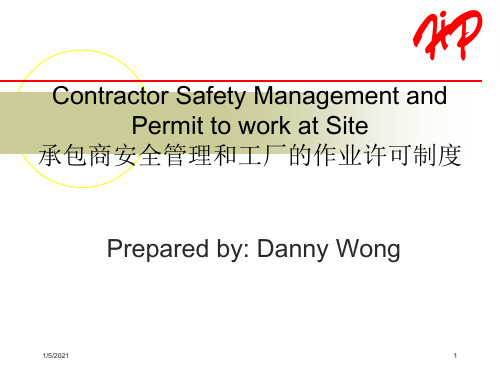
赫比联络人:负责与承包商沟通、协调,并将工程的进展向管理层汇报的员工。
1/5/2021
4
Key Definition 主要定义
Hi-P-Controlled Premises - Those premises or parts of premises occupied and managed by Hi-P or its subsidiary companies, and for which Hi-P Site Management is held accountable for safety and environmental compliance associated with the activities on the premises.
• Monitoring of contractor performance to confirm that work is being carried out to the agreed Risk Assessment, method statements and/ or standards. 监督承包商的施工以确定作业在已经确认的风险评估、工作方法陈述或标准下开展。
动火作业许可证(英文备注)

BISS Hot Work Permit动火工作许可证 No. XXXXXXXIssue Date 起草日期:…………Work starting time&date 开始时间和日期:……………Work endingtime&date:结束时间和日期………………Plant 工厂 …………Building/area 建筑/区域.:……………Equipment No.设备编号 ………..:…Job card No 工作卡编号:……………Contact person 联系人:Production 生产 ....................Contact No 电话.................... Maintenance 维护.....................Contact No 电话.......Contractor 承包商....................Contact No 电话.................... Area owner 区域负责人.................Contact No 电话............Co-sign(multiple responsibility area)共同签字(多重责任区域)……………………………………………………….Job Description 工作描述.......................................................................................................................................................................................................................................................................................Possible Measures 可能的措施 ........................................................................................................................................................YesNADone1.Lockout/Tagout 加标锁定2.Decontamination 清洁Area monitoring (e.g. Ex-lel)区域监测 Type 类别…………………Result 结果…………3.Line breaking 管道断开4.Safe watcher 安全监护人 Name 姓名____________5.PPE/Special Equipment 个人防护用品/特殊设备Description 描述 .………………………………………………………Safety watcher Name/Signature 安全监护人签字_______……………………………………………………………………………………Time 时间:__________1.Housekeeping 整洁2.Area monitoring 区域监测Type 类别……Result 结果 …………3.Recovery 恢复4.Others 其他:………………………Yes NA DoneYes NADone1. All connected pipes must be isolated.隔绝所有连接的管路 3.Surrounding floors have been swept clean and, if2. All related valves are closed, locked out and tagged bustible material exists, wet down or otherwise protected.所有相关阀门关闭,并加标锁定附近若存在易燃物质要将地面打扫干净3. The line and system must be depressurized,以及湿润或通过其他方法保护drained, purged and cleaned.管路和系统泄压、排空和清扫4.Wall and floor openings in the immediate area must be covered.4.The area must be barricaded.区域设置围栏紧靠工作区域的墙壁和地面必须覆盖保护5. Specific cleaning precautions:特殊清洁预防措施 5.Fire blanket must be used for elevated welding work 6.Others 其他高处焊接必须使用防火毯1.All the ditch, sumps, and bins in the working area YesNADone6The result of Lower Explosive Limit measurement and close surrounding area have been covered.爆炸下限测量结果工作区域及其附近地区内所有的沟渠、水坑Testing 测试项目Time( 时间)frequency 容器、箱柜、都应被覆盖保护。
工作许可制度

2 范围和宗旨 ....................................................................................................................................... 1
3 工作许可制度定义 ............................................................................................................................ 1
4 一般问题........................................................................................................................................... 1
5 如何识别潜在危险的工作、.............................................................................................................. 2
工作许可制度
WORK PERMIT SYSTEMS
AIGA 011/04
亚洲工业气体协会
地址:新加坡,3 港湾坊 #09-04 港湾大厦二, 邮编:099254 电话:+65 6276 0160 传真:+65 6274 9379 网址:
AIGA 011/04
工作许可制度
WORK PERMIT SYSTEMS
免责声明
所有AIGA或带AIGA名称的出版物包含的信息,包括业务守则、安全程序及技术信息均从AIGA认为可靠的来 源获得,并且/或者基于AIGA及其他组织成员在出版之日提供的技术信息和经验。有鉴于此,我们无法对这些 出版物所含信息的精确性、完整性或正确性作出保证,也不为此承担任何法律责任。 尽管AIGA建议其成员参考或使用协会出版物,成员或第三方对出版物的参考或使用行为纯粹出于自愿,不具 有约束力。 AIGA或其成员对参考或使用AIGA出版物所含信息或建议产生的结果不作任何担保,亦不承担任何相关的法 律责任。 AIGA无法控制任何个人或团体(包括AIGA成员)执行或不执行、误解、正确或不正确使用任何AIGA出版物 所含任何信息或建议,AIGA明确声明不承担任何与之相关的法律责任。 AIGA出版物接受定期审查,用户请注意获取最新版本。 如有任何内容方面的分歧、或经授权翻译的文件内容与本出版物的英文内容不相符合时,应以AIGA提供的 官方英文版的内容为准。 Any ambiguities or interpretive differences between an authorized translated version and the English version of this publication shall be construed and applied to preserve the meaning set forth in the official English version which is available from AIGA
工作许可证流程
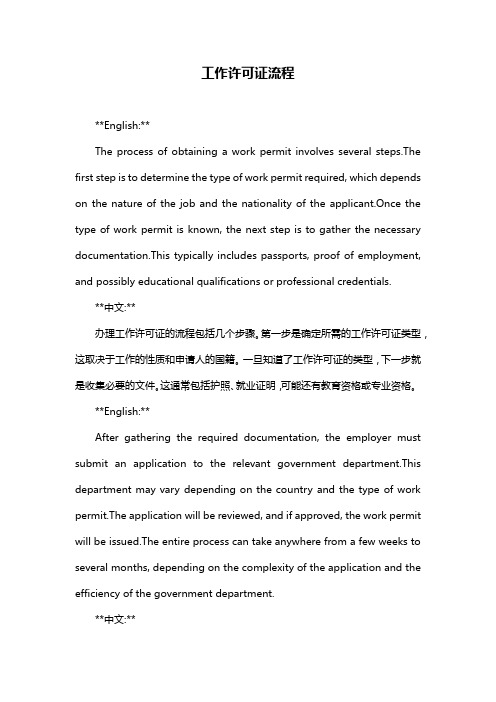
工作许可证流程**English:**The process of obtaining a work permit involves several steps.The first step is to determine the type of work permit required, which depends on the nature of the job and the nationality of the applicant.Once the type of work permit is known, the next step is to gather the necessary documentation.This typically includes passports, proof of employment, and possibly educational qualifications or professional credentials.**中文:**办理工作许可证的流程包括几个步骤。
第一步是确定所需的工作许可证类型,这取决于工作的性质和申请人的国籍。
一旦知道了工作许可证的类型,下一步就是收集必要的文件。
这通常包括护照、就业证明,可能还有教育资格或专业资格。
**English:**After gathering the required documentation, the employer must submit an application to the relevant government department.This department may vary depending on the country and the type of work permit.The application will be reviewed, and if approved, the work permit will be issued.The entire process can take anywhere from a few weeks to several months, depending on the complexity of the application and the efficiency of the government department.**中文:**在收集必要的文件后,雇主必须向相关政府部门提交申请。
工作许可证制度
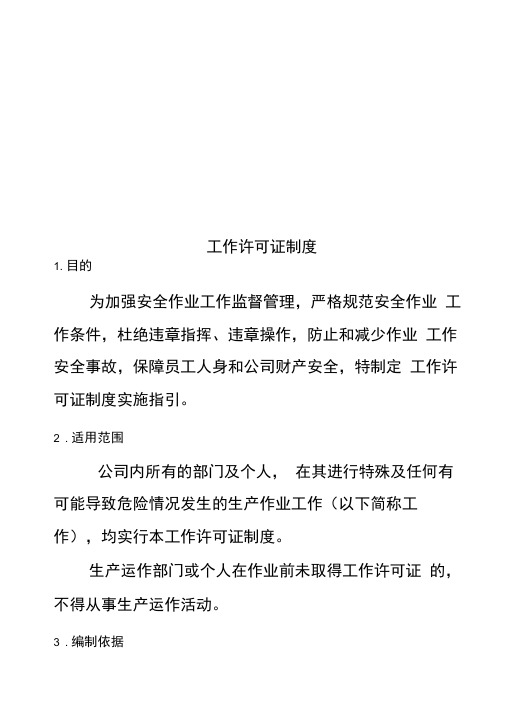
工作许可证制度1. 目的为加强安全作业工作监督管理,严格规范安全作业工作条件,杜绝违章指挥、违章操作,防止和减少作业工作安全事故,保障员工人身和公司财产安全,特制定工作许可证制度实施指引。
2 . 适用范围公司内所有的部门及个人,在其进行特殊及任何有可能导致危险情况发生的生产作业工作(以下简称工作),均实行本工作许可证制度。
生产运作部门或个人在作业前未取得工作许可证的,不得从事生产运作活动。
3 . 编制依据依据《安全生产法》、《城市燃气安全管理规定》(建设部、劳动部、公安部令第10 号)、《建设工程安全生产管理条例》、《辽宁省安全生产条例》、《城镇燃气设施运行、维护和抢修安全技术规程》CJJ51-2006 等规定制定本制度。
4 . 工作许可证类型工作许可证有二种方式,第一种工作许可证是特殊危险工作许可证,第二种工作许可证是一般工作许可证。
4.1 填用第一种工作许可证——特殊重要工作许可证的工作为:(1)燃气设施生产(停气、降压、通气、置换、开孔、封堵及恢复)作业;(2)禁火区内的动火作业;(3)进入密闭空间内作业;(4)高处作业;(5)电气作业;(6)大型吊装作业;(7)车辆或人员进入厂站限制区域。
4.2 填用第二种工作许可证——一般工作许可证的工作为:(1)设备检修作业;(2)生产设施更改;(3)设施隔离;(4)工艺参数变更;(5)加大生产负荷;(6)场站内花草修剪;(7)公司以外的人员在公司范围内进行作业等;(8)其他有可能导致危险情况发生的作业。
5. 定义5.1 工作是指直接关系员工人身健康、生命财产安全及直接关系公共安全,需要按照法定条件予以批准的特殊及任何有可能导致危险情况发生的作业活动。
5. 2 特殊危险工作是指动火作业、进入密闭空间作业、电工作业、带气作业、高处作业、大型吊装作业、拆除作业、破土破路作业、车辆或人员进入厂站限制区域等危险性很大的作业。
5. 3 一般性工作指除特殊作业以外的作业,包括厂房内重要设备、设施、仪表及管线等进行维修、保养、改动;和承包商、服务供应商、及其它公司以外的人员在公司范围内进行施工、安装、调试等一切带潜在危险性的作业活动。
005PermittoWorkManagement工作许可证管理共10页文档

PERMIT TO WORK MANAGEMENT工作许可证管理CONTENTS 目录1 PURPOSE ANDSCOPE目的和范围2 TERMINOLOGY / DEFINITIONS术语与定义3 RESPONSIBILITIES职责4 PROCEDURE 程序5 ATTACHMENTS附件1. PURPOSE AND SCOPE目的和范围1.1 The aim of this procedure is to provide guidance on the site Permit to Worksystem.本程序的目的在于就现场作业的许可证制度提出指导性意见。
1.2 The site handles a large diversity of work, so the potential for seriousaccidents is high. To prevent them it is vital that there should be safe systems of work. They will often be applied and enforced by means of a formal Permit to Work system.施工现场充满了高强度的作业,因此发生重大事故的可能性也比较高。
为了防患于未然,必须制定一套安全作业系统。
其中用得比较多的是一种正式制度是作业许可证制度。
1.3 All Critical Operations will be under the control of a Permit to Work systemoperated by the Site. Specific training will be given to all employees on the PTW system .All permit requests must be made at least 24 hours prior to work commencing.所有关键作业行为均必须处于现场作业许可证制度的控制之下。
工作许可证制度

Permit to Work 工作许可证Contractor shall describe its permit to work process.承包商应说明其工作许可证程序。
Establish the Permit to Work (PTW) system to verify that specific hazardous activities are initiated and carried out only after all possible risks related to the activity have been evaluated, and after having taken all necessary precautions related to safety of personnel and safeguard of equipment and property.建立工作许可证制度以确保有特殊危害的施工工作开始之前,识别出工作相关的潜在危险并采取相应的防范措施。
All Contractor personnel shall strictly abide by the PTW program and its relevant procedures. PTW-covered activities will not commence unless an accurately completed authorized work permit is first approved and issued. This is a mandatory procedure regardless of cost and schedule impact.承包商人员需要严格遵守工作许可证制度和相关程序,在申请得到有效的工作许可证之前,许可证覆盖的工作不得开始。
即使有可能影响费用和进度,这也是不可妥协的。
作业许可管理规定

作业许可管理规定Permit To Work Management Regulation1 目的为规范作业许可的范围、程序和要求,使各种可能造成事故的作业得到有效的控制,特制定本规定。
2 适用范围本规定适用于船舶及海工建造过程中的作业许可:2.1 热工作业2.2 密闭舱室油漆作业2.3 临时接电2.4 脚手架搭、改、拆作业2.5 射线照相作业2.6 开/关舱室出入孔盖作业2.7 化学制剂/易燃易爆等危险品上船作业2.8 船底塞开启作业2.9 压载/去除压载作业2.10 船舶液压管试验作业2.11 加油、驳油作业2.12 清油作业2.13 午间及夜间作业2.14 二氧化碳(泡沫、哈龙)间作业2.15 狭小空间或密闭舱室气体保护焊作业2.16 锚地作业2.17 锅炉点火试验2.18 高压电气作业2.19 高压管压力试验作业2.20 管系串油作业2.21 船台滑道下水作业2.22 其他危险性作业3 定义和术语3.1 作业许可:指在危险作业开始前,确认各项防护措施已有效落实,而采取的一种审批形式。
4 涉及岗位4.1 总经理、副总经理、4.2 安全环境监督部经理/副经理、安全主管4.3 制造部经理/副经理、项目经理、建造经理4.4 各车间主任/副主任、工程主管、调试主管、作业长、安全管理员、安监员5 管理和操作流程5.1 “作业许可证”需包含但不限于以下内容:5.1.1 作业的名称、项目和具体部位。
5.1.2 申请部门和现场施工班组信息。
5.1.3 施工现场班组负责人、监护人以及作业人数信息。
5.1.4 针对性的职业健康安全和环保(HSE)预防措施。
5.1.5 申请、审批和签发人员的签认以及日期。
5.1.6 许可的有效期限。
5.2 申请前工作5.2.1 提交作业申请前,工程主管必须在单船/项目安全协调会(PSCC)上明确声明所要进行的作业,同时向项目安全主管提交每日工程清单(Daily Work List)。
现场安全考核办法双语版

安全管理考核办法HSE penalties目录content第一章总则Chapterone General第二章工作许可证Chapter two Permit To Work第三章上锁挂签Chapter three Lockout and Tagout第四章事故报告与调查Chapter four Incidents reporting and investigation第五章安全设备维护与检查Chapter five safety equipments maintenance and inspection第六章应急反应Chapter six Emergency response第七章安全台账管理Chapter seven HSE files management第八章现场安全管理Chapter eight Site HSE management第九章安全奖励Chapter nine HSE reward第一章:总则Chapter one: General第1条:为了规X我厂各级管理部门及全体员工的行为,安全高效的完成各项工作任务,使企业规X化、制度化、科学化,根据有关法律法规,行业标准和公司安全管理体系文件特制定本办法。
In order to improve the behavior of all personnel on board, ensure a safe and efficient pletion of various tasks, and a continuous improvement of HSE management. in accordance with relevant laws and regulations of industry standards and pany HSE MSthe followingrules are formulated.第2条:凡在我公司各工种岗位的所有员工,包括承包商,都必须切实按照本办法的规定做好本职工种。
Golden Safety Manual(安全黄金手册)
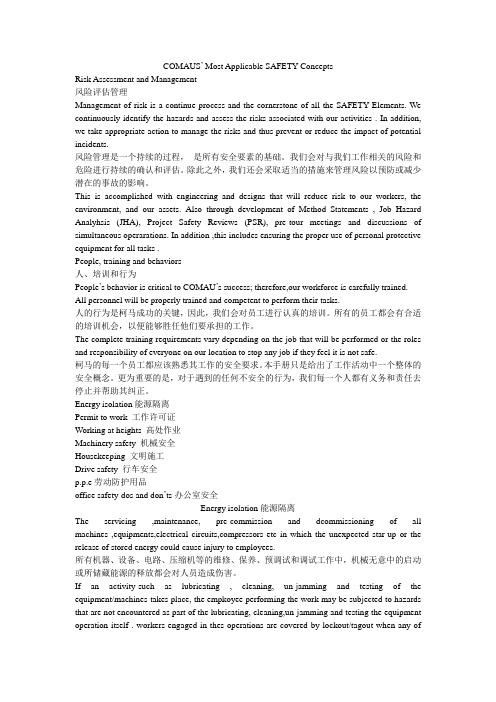
COMAUS’ Most Applicable SAFETY ConceptsRisk Assessment and Management风险评估管理Management of risk is a continue process and the cornerstone of all the SAFETY Elements. We continuously identify the hazards and assess the risks associated with our activities . In addition, we take appropriate action to manage the risks and thus prevent or reduce the impact of potential incidents.风险管理是一个持续的过程,是所有安全要素的基础。
我们会对与我们工作相关的风险和危险进行持续的确认和评估。
除此之外,我们还会采取适当的措施来管理风险以预防或减少潜在的事故的影响。
This is accomplished with engineering and designs that will reduce risk to our workers, the environment, and our assets. Also through development of Method Statements , Job Hazard Analyhsis (JHA), Project Safety Reviews (PSR), pre-tour meetings and discussions of simultaneous operarations. In addition ,this includes ensuring the proper use of personal protective equipment for all tasks .People, training and behaviors人、培训和行为People’s behavior is critical to COMAU’s success; therefore,our workforce is carefully trained.All personnel will be properly trained and competent to perform their tasks.人的行为是柯马成功的关键,因此,我们会对员工进行认真的培训。
有限空间作业审批制度(详细版)

有限空间作业审批制度(详细版)XXXThe purpose of this system is to standardize the safety management of limited space work。
strengthen the approval process。
prevent and control n safety XXX work.Scope: XXX.Responsibilities: The Environmental and Safety Department is XXX.Content:1.XXX the outside world。
have narrow entrances and exits。
and where workers cannot work for long ds of time。
Poor natural XXX。
flammable。
XXX.2.XXX 1 XXX.3.Without approval。
no one is allowed to enter limited space work alone.4.The work permit should include basic n about the work activity。
including the department。
work area。
work scope。
work time。
work hazards and control measures。
work n。
work approval。
and work closure.5.n for the license:5.1 Provide n materials: The person in charge of the work is XXX and should prepare the XXX:Detailed n of the limited space workResults of the work safety analysisXXXXXX recordsXXX5.2 Work safety analysis: The content of the work safety analysis should include work steps。
工作许可安全管理制度
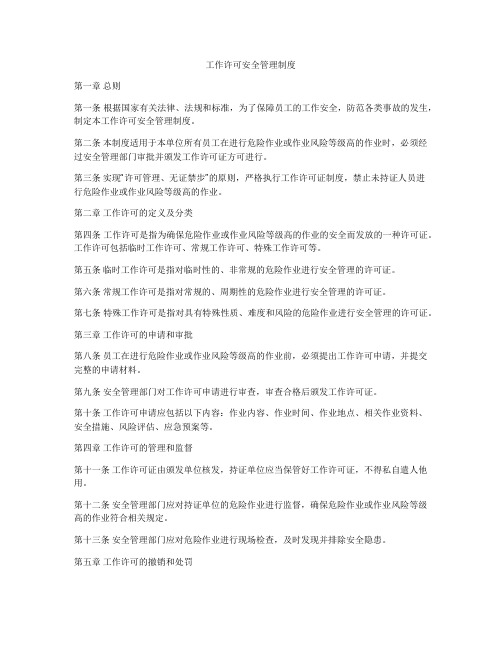
工作许可安全管理制度第一章总则第一条根据国家有关法律、法规和标准,为了保障员工的工作安全,防范各类事故的发生,制定本工作许可安全管理制度。
第二条本制度适用于本单位所有员工在进行危险作业或作业风险等级高的作业时,必须经过安全管理部门审批并颁发工作许可证方可进行。
第三条实现“许可管理、无证禁步”的原则,严格执行工作许可证制度,禁止未持证人员进行危险作业或作业风险等级高的作业。
第二章工作许可的定义及分类第四条工作许可是指为确保危险作业或作业风险等级高的作业的安全而发放的一种许可证。
工作许可包括临时工作许可、常规工作许可、特殊工作许可等。
第五条临时工作许可是指对临时性的、非常规的危险作业进行安全管理的许可证。
第六条常规工作许可是指对常规的、周期性的危险作业进行安全管理的许可证。
第七条特殊工作许可是指对具有特殊性质、难度和风险的危险作业进行安全管理的许可证。
第三章工作许可的申请和审批第八条员工在进行危险作业或作业风险等级高的作业前,必须提出工作许可申请,并提交完整的申请材料。
第九条安全管理部门对工作许可申请进行审查,审查合格后颁发工作许可证。
第十条工作许可申请应包括以下内容:作业内容、作业时间、作业地点、相关作业资料、安全措施、风险评估、应急预案等。
第四章工作许可的管理和监督第十一条工作许可证由颁发单位核发,持证单位应当保管好工作许可证,不得私自遣人他用。
第十二条安全管理部门应对持证单位的危险作业进行监督,确保危险作业或作业风险等级高的作业符合相关规定。
第十三条安全管理部门应对危险作业进行现场检查,及时发现并排除安全隐患。
第五章工作许可的撤销和处罚第十四条安全管理部门有权对持证单位的违规行为进行处理,包括撤销工作许可证、停止危险作业等。
第十五条对于因违反工作许可管理制度导致事故发生的,安全管理部门将追究相关责任人的法律责任。
第六章附则第十六条本制度由安全管理部门负责解释。
第十七条本制度自颁布之日起生效,如有补充或修订,另行发布。
work permit residence permit -回复
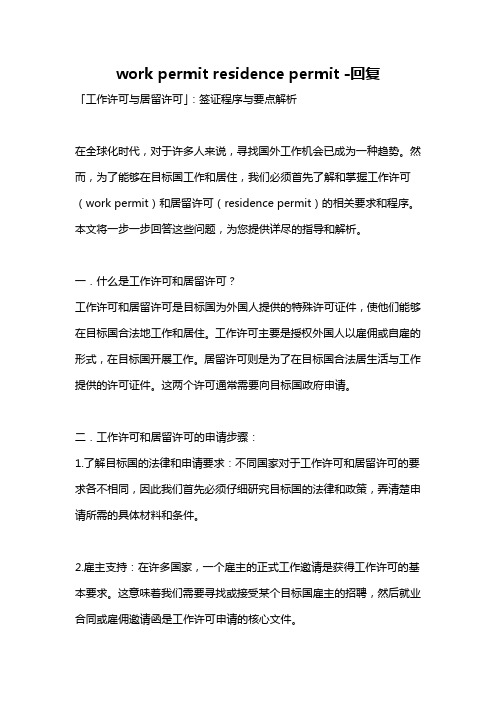
work permit residence permit -回复「工作许可与居留许可」:签证程序与要点解析在全球化时代,对于许多人来说,寻找国外工作机会已成为一种趋势。
然而,为了能够在目标国工作和居住,我们必须首先了解和掌握工作许可(work permit)和居留许可(residence permit)的相关要求和程序。
本文将一步一步回答这些问题,为您提供详尽的指导和解析。
一.什么是工作许可和居留许可?工作许可和居留许可是目标国为外国人提供的特殊许可证件,使他们能够在目标国合法地工作和居住。
工作许可主要是授权外国人以雇佣或自雇的形式,在目标国开展工作。
居留许可则是为了在目标国合法居生活与工作提供的许可证件。
这两个许可通常需要向目标国政府申请。
二.工作许可和居留许可的申请步骤:1.了解目标国的法律和申请要求:不同国家对于工作许可和居留许可的要求各不相同,因此我们首先必须仔细研究目标国的法律和政策,弄清楚申请所需的具体材料和条件。
2.雇主支持:在许多国家,一个雇主的正式工作邀请是获得工作许可的基本要求。
这意味着我们需要寻找或接受某个目标国雇主的招聘,然后就业合同或雇佣邀请函是工作许可申请的核心文件。
3.准备申请文件:根据目标国的要求,补充和准备所有申请所需的文件,如护照复印件、雇主担保信、个人简历、工作经历证明、学历证明、犯罪记录证明等。
确保所有文件的真实、有效和及时性。
4.递交申请:将申请文件提交给目标国政府有关机构,如移民局或驻外大使馆。
一般来说,我们可以通过在线系统或邮寄方式提交申请文件。
5.等待批准:接下来就是等待目标国政府的审批结果。
根据申请人的个人情况以及目标国政府的工作效率,审批时间可能会有所不同。
一些国家提供加急处理的选项,但通常需要额外费用。
6.获得许可证:一旦工作许可或居留许可申请被批准,我们将获得相应的许可证。
这份许可证是在目标国合法工作和居住的凭证,需要我们随身携带,并在要求的场合出示。
Q_SY1240-2009作业许可管理规范
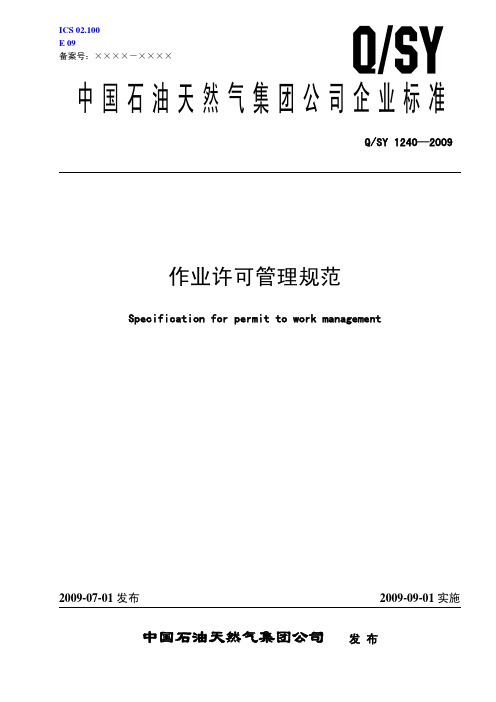
5.1 作业许可范围 5.1.1 在所辖区域内或在已交付的在建装置区域内,进行下列工作均应实行作业许可管理,办理作业许 可证:
——非计划性维修工作(未列入日常维护计划或无程序指导的维修工作); ——承包商作业; ——偏离安全标准、规则、程序要求的工作;
1
Q/SY 1240—2009
——交叉作业; ——在承包商区域进行的工作; ——缺乏安全程序的工作。 对不能确定是否需要办理许可证的其他工作,办理许可证。作业许可管理流程见附录 A。
I
Q/SY 1240—2009
前言
本标准的附录 A、附录 B、附录 C 是资料性附录。 本标准由中国石油天然气集团公司标准化委员会健康安全环保专业标准化技术委员会提出并归口。 本标准负责起草单位:中国石油安全环保技术研究院。 本标准参加起草单位:中国石油大港石化公司。 本标准主要起草人:谢国忠、王泽华、李斌、华胜、侯永平、夏春英、李世森。
ICS 02.100 E 09 备案号:××××-××××
中国石油天然气集团公司企业标准
Q/SY 1240—2009
作业许可管理规范
Specification for permit to work management
2009-07-01 发布
2009-09-01 实施
中国石油天然气集团公司 发 布
注:这里的承包商作业是指由承包商完成的非常规作业活动。
5.1.2 如果工作中包含下列工作,还应同时办理专项作业许可证: ——进入受限空间; ——挖掘作业; ——高处作业; ——移动式吊装作业; ——管线打开; ——临时用电; ——动火作业。
5.1.3 企业应按照本规范的要求,结合企业作业活动特点、风险性质,确定需要实行作业许可管理的范 围、作业类型,确保对所有高风险的、非常规的作业实行作业许可管理。 5.2 作业许可证申请 5.2.1 作业前申请人应提出申请,填写作业许可证,作业许可证参见附录B。同时提供以下相关资料:
- 1、下载文档前请自行甄别文档内容的完整性,平台不提供额外的编辑、内容补充、找答案等附加服务。
- 2、"仅部分预览"的文档,不可在线预览部分如存在完整性等问题,可反馈申请退款(可完整预览的文档不适用该条件!)。
- 3、如文档侵犯您的权益,请联系客服反馈,我们会尽快为您处理(人工客服工作时间:9:00-18:30)。
PERMIT TO WORK MANAGEMENT工作许可证管理CONTENTS 目录1 PURPOSE ANDSCOPE目的和范围2 TERMINOLOGY / DEFINITIONS术语与定义3 RESPONSIBILITIES职责4 PROCEDURE 程序5 ATTACHMENTS附件1. PURPOSE AND SCOPE目的和范围1.1 The aim of this procedure is to provide guidance on the sitePermit to Work system.本程序的目的在于就现场作业的许可证制度提出指导性意见。
1.2 The site handles a large diversity of work, so the potentialfor serious accidents is high. To prevent them it is vital that there should be safe systems of work. They will often be applied and enforced by means of a formal Permit to Work system.施工现场充满了高强度的作业,因此发生重大事故的可能性也比较高。
为了防患于未然,必须制定一套安全作业系统。
其中用得比较多的是一种正式制度是作业许可证制度。
1.3 All Critical Operations will be under the control of a Permitto Work system operated by the Site. Specific training will be given to all employees on the PTW system .All permit requests must be made at least 24 hours prior to work commencing.所有关键作业行为均必须处于现场作业许可证制度的控制之下。
全体员工均必须接受有关作业许可证制度的具体培训。
各种作业许可证都必须在作业开始之前至少提前二十四小时提出申请。
1.4 Routine Operations will not be covered by Permit to Work.常规作业不需要办理作业许可证。
2. TERMINOLOGY / DEFINITIONS术语/定义PTW - Permit to Work作业许可证Critical Operations - Critical operations include hot works in vicinity of the area that have inflammable material storage, enter into vessels/equipment or any confine space work,temporary electrical work electrical work, excavations deep than 300mm; use of radioactive, spray painting and gritblasting ,use of cartridge tools ,use of man baskets, erection or removal of flooring and handrails on open steelwork, diving operations and explosive material,; pressure testing, lifting operations over 50 tons and multi-crane lifting work and any other operations which might be identified during the progress of the project that need to be covered under the Permit to Work system.关键作业---关键作业包括在材料存放有可燃性材料的区域附近进行的高温(动火)作业、进入容器、设备和密闭空间作业、临时性电气作业、超过0.3米的开掘作业、放射性、喷漆和喷砂作业、使用冲击工具、使用载人吊舱,载开放式钢架上架设或移除地板和栏杆、潜水作业和易爆炸材料的使用、压力测试作业、使用多台(含两台)吊机起吊或超过五十吨以上的起吊作业以及项目进行过程中识别出来的其它适用作业许可证制度的各类作业。
Routine Operations – Operations in areas solely designated for operations will not require Permit to Work even though critical operations are carried out. For example a workshop or grit blastin g area where hot work is considered “normal operation” will not require Permit to Work. However these activities must be covered under other SSPs or specialprocedure for the area. Any other work that is not covered under the area’s procedure will require a Permit to Work.常规作业---这是指那些在专属区域进行的、但不需要取得作业许可证就可以施工的作业(即使是关键作业)。
例如在喷钢砂处理区域,高温作业是“常规操作”,所以就不必申请作业许可证。
但是,在这些区域进行作业时,必须接受其它现场安全规定或适用该区域的特殊程序的控制。
超出区域程序范围的任何作业,必须申请并获得作业许可证方可实施。
3. RESPONSIBILITIES职责3.1 The Safety Manager is responsible for ensuring that thisprocedure is implemented. He is also responsible for the checking of the effectiveness of the Permit to Work system by carrying out random audits at the work site.安全经理负责该程序的实施。
其另一个任务是通过现场的随机审核,负责检查并评估作业许可证制度的落实情况。
3.2 The Safety engineer is responsible for ensuring that thisprocedure is adhered to at all times.安全工程师负责该程序在日常工作中的全面贯彻实施。
3.3 The safety engineer is responsible for approving the Permitto Work operated on his project/area is clearly understood and adhered to by all contractors under their control.安全工程师负责本项目/本区域作业许可证的批准和实施,确保其负责管理的全体承包商正确理解并严格遵守相关的条例和制度。
3.4 The duties of the safety engineer are:安全工程师的职责是:3.4.1 To be the co-coordinator of all permit work at the facility,including those permits which are suspended, but where thework is not complete充当本区域所有与作业许可证制度有关事宜的协调员,包括那些许可暂时收回,但工作尚未完成的作业的后续处理事宜。
3.4.2 To keep the Construction Manager informed of anypotentially hazardous situations arising from permit work,advise the Construction Manager of any activities that needto be bought under the control of the PTW system and toensure all staff involved have an overview of significantongoing work为了保证施工经理及时掌握由于作业而引起的各种潜在危险情况,应该加强与施工经理的沟通,及时提醒其开展作业许可制度规定的各种行动,确保所有的相关员工从总体上了解正在进行的各项重要作业。
3.4.3 To operate the permit issue point to reflect the currentstate of work及时解决作业许可证制度在当前执行过程中出现的各种问题。
3.4.4 To provide a quality check on the completion of permits在许可证的任务完成以后,负责检查作业许可证的完成情况。
3.4.5 To be the focal point for PTW at the location, and generatea sense of ownership in those individuals who work with thesystem.担当本区域作业许可证制度的推行重任,培养有关员工的主人翁意识3.4.6 Monitor all aspects of the PTW procedure.监督实施作业许可证制度的各方面工作。
3.4.7 Identify any changes required to the PTW procedure to allowfor continuous improvement.适时地对作业许可证制度作出修改,以实现持续改善的目的。
3.4.8 Liaise with the electrical Competent person to allow forcorrect isolations.加强与电气专业人员的联系,对电气设施采取正确的隔离措施。
